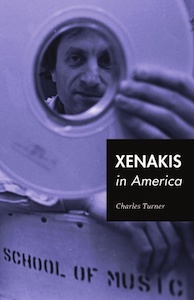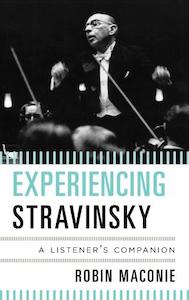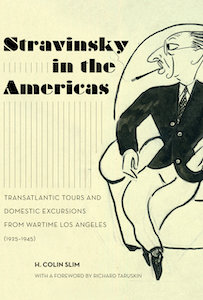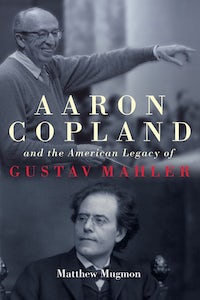Xenakis and Stravinsky in America, Mahler too (via Copland)
|
Grant Chu Covell [December 2021.]
Charles W. TURNER: Xenakis in America (2014). One Block Avenue ISBN 9780692267165 (www.oneblockavenue.net). This is not a big book, but it is an interesting slice of history. Copland invited Xenakis to Tanglewood in 1963, and between 1967 and ’72, Xenakis taught at Indiana University. Leveraging detailed research in the US and France, Turner writes in a clear, factual style presenting Xenakis’ American experiences. We learn what life at Indiana was like, who worked with Xenakis, and what projects the composer undertook. Turner reminds us that the electronics we take for granted today, that nestle inside our cellphones and computers, were once impossible. For five years a scattershot team of musicians, novice programmers and part-time electronics engineers (maybe better to call them electronics enthusiasts) struggled to build a digital-to-analog converter. At the time, IU was no different than its peers in that computer science, electrical engineering and music were separate fiefdoms, and at the start of Xenakis’ tenure, new music was considered an unwelcome distraction from the traditional conservatory curriculum. No wonder it was hard for Xenakis to get anything done academically in the US, although, these were the years he wrote Kraanerg (1968), Persephassa (1969) and Persepolis (1971), and his Oresteia (1965-65) was premiered in the US. Reading this makes me sad about Contemporary Music in America. Xenakis could have done interesting things, but no, America, and perhaps the world, was not yet ready.
Robin MACONIE: Experiencing Stravinsky (2013). Scarecrow Press ISBN 9780810884304 (www.rowman.com). Considering Stravinsky’s music as it relates to technology and how the composer sought to make his works permanent is an unusual angle to ply when discussing a composer’s entire oeuvre. It so happens that where Stravinsky is concerned, there is ample source material to work with. However, as an introductory guide, or even as reference material, this eccentric book proves unsatisfying and unhelpful. A Stravinsky fan may find new ideas to chew on, but casual readers will be in worse shape than before. Readers of these pages might recall Maconie as author of a continually improved handbook on Stockhausen (iteration three is covered here). This book introduces us to an uninhibited musicologist, overwhelming readers with an idiosyncratic view of music history. Among Maconie’s interesting concepts: The Rake’s Progress was really about rehabilitating Stravinsky’s legacy, the plot is apparently autobiographical, Auden and Kallman’s involvement notwithstanding. The opera represents Stravinsky’s triumph over the English language and Mozart. Maconie insists that the composer kept abreast of all sorts of current technology (from player pianos to computers) and contemporary music. We learn that Stravinsky’s disinclination towards strings was because they did not record well. Almost expectably, Maconie finds Stockhausen’s influence in late Stravinsky. The editors permitted Maconie an astonishing free range. There are no musical examples. The widely ranging music references (again, no examples!) from de Falla and Rimsky-Korsakov to Varèse and Carter are vast and circumstantial, completely unhelpful without prior acquaintance or independent excursions. Maconie lards his descriptions with topical allusions which can encumber a naïve reader. There are catty anecdotes, and Maconie’s name-dropping, pretentious style proves tiresome, if not emphatically alienating. Why does he invent imaginary conversations that reflect poorly upon their speakers? This could have been a slimmer and more useful volume if it were clearer and less fancifully opinionated. Actually, this is a perfectly fine introduction to Stravinsky if you are not interested in music.
H. Colin SLIM: Stravinsky in the Americas (2019). University of California Press ISBN 9780520299924 (www.ucpress.edu). By the 1920’s Stravinsky’s fame had been established with his early ballet scores. He embodied the peak of Russian Romanticism with The Firebird (1910) and then Modernity with Le Sacre du Printemps (1913). Stravinsky’s turn towards Neoclassicism perplexed and confused audiences. Slim illuminates Stravinsky’s early years in the US (1925-45). This period included North and South American tours, residences on both coasts (Cambridge, MA, and Los Angeles, CA), and eventual US citizenship in December 1945. Robert Craft did not firmly enter the picture until later in the 1940s. It can be argued that the years covered by this book document an unmoored composer and musician, a revolutionary seeking a new homeland and style. Slim’s hefty book was an opportunity to revisit a barrelful of less-familiar music such as Four Norwegian Moods (1942), Ode (1943), Babel (1944), the Ebony Concerto (1945), and the Concerto in D for string orchestra (1946). Some of these pieces are decidedly less frequently programmed than the early ballets, and they may even be more obscure than some of the later serial compositions. Other works, like Babel, are understandably forgotten. Slim makes the case that the Neoclassical items should be called Ironic, which makes wonderful sense. As much as Stravinsky was looking for a home and secure income, perhaps too he was searching for a style or a system. There is no doubt that his orchestral palette remained consistent from the Symphonies of Wind Instruments (1920) onwards, but sourcing the right melodic material seems to have been a struggle. The Star-Spangled Banner (1941) arrangement, the Circus Polka (1942) and the Greeting Prelude (1955) are explicit copies of other pieces, wrapped in Stravinsky’s particular instrumentation. Dumbarton Oaks (1938) and the Ebony Concerto (1945) are parodies, caricatures of the Brandenburg concertos and jazz. Many of the works from 1925-45 sound insecure, as if tired of the work which the Rite or the Piano Concerto required, Stravinsky was fishing for a system that would help. Slim doesn’t explicitly draw conclusions. He takes time to chronicle Stravinsky’s life during this period, with anecdotes, illustrations and brief analyses, letting the facts and music speak for themselves. Essentially, we witness Stravinsky’s trials and joys at making sense of a new country. Slim wraps up just before Craft takes over the narrative.
Matthew MUGMON: Aaron Copland and the American Legacy of Gustav Mahler (2019). University of Rochester Press ISBN 9781580469647 (www.urpress.com). The title got my attention, but the content didn’t live up to expectations. Copland doesn’t make sense as an Austro-Germanic Romantic torchbearer. I think I have sufficient imagination, however, connecting Copland’s Symphonic Ode with Mahler’s Das Lied doesn’t work for me. Maybe there are structural coincidences, a few orchestral tricks, or perhaps even a similar harmonic progression here and there. But I am just not hearing it. Most every composer has explored the unresolved second hovering above a major triad which we find in Der Abschied’s final bars. Likewise, it’s hard to fathom that Music for the Theatre and the Ninth may also have deep similarities. Since there were melodies, composers have incorporated folk tunes, sometimes explicitly or deeply variated. It’s not hard to scratch around and find coincidences between any two pieces picked at random. Copland conducted Xenakis’ Pithoprakta in San Francisco in 1966, but this doesn’t automatically mean that Copland became interested in stochastic processes, nor does it warrant an exploration into how aspects of late-Copland wind writing reflect an application of set theory. Mugmon’s arguments are painstakingly assembled, however, pedantic delineation and repetition doesn’t make for convincing conclusions. The few written sources seem circumstantial and could be interpreted widely. Roping in Nadia’s Boulanger’s thoughts, bits of Copland’s letters, and triangulating Copland and Mahler with Koussevitsky, and then with Bernstein, stretches Mugmon’s thesis absurdly. Eventually Mugmon admits Copland’s later ambivalence to Mahler, and we should wonder what started this goose chase in the first place. I think Copland gravitated towards a style that worked for him, and maybe he admired some of Mahler’s tricks of the trade, but there could be just as many accidental precedents found in Saint-Saëns or Sibelius using Mugmon’s thin methods. Why not find Richard Strauss in Elliott Carter, or Verdi in Virgil Thomson? The book’s most interesting section doesn’t concern Copland per se. Mugmon investigates Koussevitzky’s different performances of Mahler’s Ninth and the cuts that were made. Abridgements were common back in the day, when tightening what was unfamiliar may have made it more palatable. It amazes to know that first audiences may have experienced the Rondo-Burlesque without the Finale foreshadowing.
[More Books, Grant Chu Covell]
[Previous Article:
Used Bin Troll Tweets CCC.]
[Next Article:
Used Bin Troll Tweets DDD.]
|



